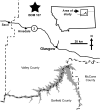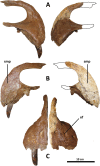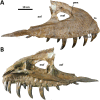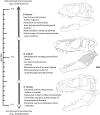A transitional species of Daspletosaurus Russell, 1970 from the Judith River Formation of eastern Montana
- PMID: 36452080
- PMCID: PMC9703990
- DOI: 10.7717/peerj.14461
A transitional species of Daspletosaurus Russell, 1970 from the Judith River Formation of eastern Montana
Abstract
Here we describe a new derived tyrannosaurine, Daspletosaurus wilsoni sp. nov., from Judithian strata (~76.5 Ma) intermediate in age between either of the previously described species of this genus. D. wilsoni displays a unique combination of ancestral and derived characteristics, including a cornual process of the lacrimal reduced in height relative to D. torosus and more basal tyrannosaurines, and a prefrontal with a long axis oriented more rostrally than in D. horneri and more derived tyrannosaurines. The description of this taxon provides insight into evolutionary mode in Tyrannosaurinae, lending strength to previous hypotheses of anagenesis within Daspletosaurus and increasing the resolution with which the evolution of this lineage can be reconstructed. Cladistic phylogenetic methods, stratigraphy, and qualitative analysis of the morphology of relevant taxa supports an anagenetic model for the origin of morphological novelty in this genus, highlighting the predominance of anagenetic evolution among contemporary dinosaur lineages.
Keywords: Anagenesis; Daspletosaurus; Paleontology; Tyrannosaur.
© 2022 Warshaw and Fowler.
Conflict of interest statement
The authors declare they have no competing interests.
Figures













Similar articles
-
A new tyrannosaur with evidence for anagenesis and crocodile-like facial sensory system.Sci Rep. 2017 Mar 30;7:44942. doi: 10.1038/srep44942. Sci Rep. 2017. PMID: 28358353 Free PMC article.
-
Reassessment of a juvenile Daspletosaurus from the Late Cretaceous of Alberta, Canada with implications for the identification of immature tyrannosaurids.Sci Rep. 2019 Nov 28;9(1):17801. doi: 10.1038/s41598-019-53591-7. Sci Rep. 2019. PMID: 31780682 Free PMC article.
-
A New Brachylophosaurin Hadrosaur (Dinosauria: Ornithischia) with an Intermediate Nasal Crest from the Campanian Judith River Formation of Northcentral Montana.PLoS One. 2015 Nov 11;10(11):e0141304. doi: 10.1371/journal.pone.0141304. eCollection 2015. PLoS One. 2015. PMID: 26560175 Free PMC article.
-
The origin and early evolution of dinosaurs.Biol Rev Camb Philos Soc. 2010 Feb;85(1):55-110. doi: 10.1111/j.1469-185X.2009.00094.x. Epub 2009 Nov 6. Biol Rev Camb Philos Soc. 2010. PMID: 19895605 Review.
-
Tyrannosaur paleobiology: new research on ancient exemplar organisms.Science. 2010 Sep 17;329(5998):1481-5. doi: 10.1126/science.1193304. Science. 2010. PMID: 20847260 Review.
Cited by
-
Lokiceratops rangiformis gen. et sp. nov. (Ceratopsidae: Centrosaurinae) from the Campanian Judith River Formation of Montana reveals rapid regional radiations and extreme endemism within centrosaurine dinosaurs.PeerJ. 2024 Jun 20;12:e17224. doi: 10.7717/peerj.17224. eCollection 2024. PeerJ. 2024. PMID: 38912046 Free PMC article.
-
A giant tyrannosaur from the Campanian-Maastrichtian of southern North America and the evolution of tyrannosaurid gigantism.Sci Rep. 2024 Jan 11;13(1):22124. doi: 10.1038/s41598-023-47011-0. Sci Rep. 2024. PMID: 38212342 Free PMC article.
References
-
- Brochu CA. Osteology of Tyrannosaurus rex: insights from a nearly complete skeleton and high-resolution computed tomographic analysis of the skull. Journal of Vertebrate Paleontology. 2003;22(Sup4):1–138. doi: 10.1080/02724634.2003.10010947. - DOI
-
- Brown CM, Currie PJ, Therrien F. Intraspecific facial bite marks in tyrannosaurids provide insight into sexual maturity and evolution of bird-like intersexual display. Paleobiology. 2022;48(1):12–43. doi: 10.1017/pab.2021.29. - DOI
-
- Brusatte SL, Carr TD, Norell MA. The osteology of Alioramus, a gracile and long-snouted tyrannosaurid (Dinosauria: Theropoda) from the Late Cretaceous of Mongolia. Bulletin of the American Museum of Natural History. 2012;2012(366):1–197. doi: 10.1206/770.1. - DOI
Publication types
MeSH terms
LinkOut - more resources
Full Text Sources

